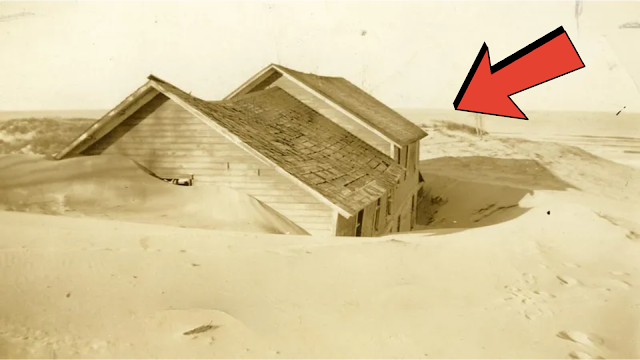Michigan, a town so profoundly bad at being a town that it wiped itself off the map and drowned itself in this sand.
How did this happen and could it happen to just anyone or only a town as
messy as Singapore?
A man named O'Shea Wilder, a bank, a sawmill, and a dream.
Wilder arrived in Singapore in 1837, just in time for the Panic of 1837,
which put the town on the economic struggle bus from the start.
Nonetheless, it found its footing in the lumber and shipping industry.
At its peak, almost 300 people lived there and delivered millions of
feet of lumber each year, and they had a talent for turning bad news into good.
In 1842, a very harsh winter caused a serious ship accident.
Luckily, the ship had lots of flour and wine, which helped the town
survive.
Then, in 1859, the river knocked down their lighthouse.
Instead of rebuilding it, they were happy because they didn't have to
maintain it anymore.
In 1871, a big fire burned many places in the upper Midwest, like Peso,
Holland, Port Heron, Moniz, and even Chicago.
But Singapore didn't get burned, and they saw this as a big chance to
sell their goodwood to rebuild those burnt places.
So, they cut down all their white pine trees to sell, but later, they
realized it was a bad idea, not just because it's not sustainable.
Sand dunes are mostly by the ocean, but you can find them along the
eastern shore of Lake Michigan too.
These dunes are really old, up to 4,500 years. Here's how they form, the
river brings sand to the lake, or sand erodes off or bluff.
The waves carry it to the beach, and when the water levels go down, the
wind blows it to the land.
Plants and things catch the sand and start gathering it into a ridge.
The wind blows more sand onto the ridge, and it keeps piling up until you've
got a dune.
Plants help start the dune, but most of the work to keep it stable is
done by the plants.
They catch the wind above ground and anchor the sand below, making it
harder for the wind to blow it away.
Plants grow on the dune in three stages, one after the other, moving
further from the beach over time.
Talking about sand dunes, we're talking about a process that starts with
small plants called pioneers.
These pioneers help to build up the sand and turn it into soil, which
then supports bigger plants like shrubs, vines, and small trees.
The more plants there are, the more stable the land becomes. But it's a
fragile balance because if something like a fire destroys the plants, you can't
just plant new ones.
You have to wait for the pioneers to start the process all over again.
Eventually, if everything goes well, you end up with a full forest.
This forest is rare, especially with white pine trees, which are great
for lumber.
In the case of Singapore, they harvested all their pine trees, not
realizing they were the only thing keeping the sand dunes stable.
When the winds blew, the sand from the dunes covered the town. Realizing
their mistake, people began leaving Singapore.
They sold off buildings and even moved houses down the river.
The last family to leave kept moving up floors in their house as the
sand piled up until they had to leave too.
By 1894, Singapore was completely deserted and buried in sand. This
problem isn't just from the 19th century.
Even today, we see dunes causing issues in places like Indiana Dunes
National Park, where they're encroaching on buildings.
Singapore serves as a reminder that we need to understand the
environment before making big changes.
As for Singapore today, it's mostly just sand. We're not exactly sure
what's underneath it all, but with proper archaeology.
We might find clues to the town's past, including potentially preserved
houses buried in the sand.
People have noticed parts of a dock in the fence around the graveyard.
The future of the area is uncertain, there have been plans for a marina
housing development and golf course, but historians and locals are against it.
They're saying, no way. Whatever happens to Singapore, let's hope it
stays above ground this time.
Thank you for watching.







No comments: